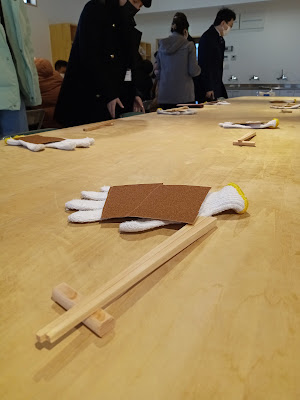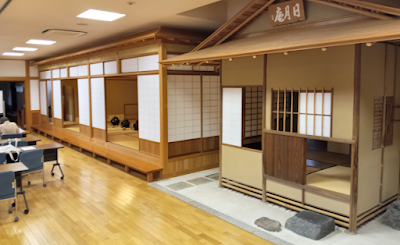Expectations of own outcome & imagining resources there
Expectations for self
Three weeks of lectures and visual experience, meetings, conversations to learn along with and from fellow participants' point of view, as well as field trips adds up to a lot of information, knowledge, and possibly wisdom to distill from the learning experiences. What are some reasonable expectations (mingled with aspirations) at the conclusion of the study program; and what may follow in the months or years that follow?
During the seminar: It will take a little while to settle into the routines and rhythm of the program, but then there should be a good balance of prepared/formal instruction and guided discussion with other parts that are less structured. Getting adjusted to language use, both written and spoken, will take some energy and attention, as well, especially at first. Upshot: risk of Too Much Information (hearing but not fully grasping or fitting into prior knowledge). Therefore, prioritize to hold focus on main thread instead of fine-points, texture and tone.
By its concluding day: Three layers of knowledge will be in hand - printed (or PDF) materials to review and return to later [reference], session notes and pictures to form one's own synthesis of the subjects, and then what is fully incorporated into "working knowledge" of Japanese land and language. To be more specific, the broad headings of each day's presentations will now be filled in with citations, illustrations and examples, as well as responses to personal interest areas about Shinto: structure, function (in history and today), experience, recognizing words and non-written signs and meanings encountered in the landscape and popular culture, and in each of the 5 kinds of Shinto (shrine, home, state, imperial, folk/community-rooted instances).
By contrast to peers with Japan expertise, those who have not taken the 3-week course of topics and conversations, those who complete the 2023 sessions will be acquainted with Persons, Places, Things of Shinto far beyond the surface knowledge of Torii and Matsuri. And by contrast to people growing up in Japan, too, much of the teaching and field trip learning will go above and beyond what is conveyed on TV, in school assignments, and experienced around one's own neighborhood.
Subsequently: A month or two after the 2023 cycle wraps up March 10, most participants will be busy with the things they were doing before things began on February 20 - graduate studies, fieldwork or dissertation writing, full or part-time employment, reading and writing, and so on. However, thanks to the 3 weeks of Shinto studies, perhaps the surrounding cultural landscape will have a new layer of meaning. The relationship between people and their familiar surroundings will have new associations and possibilities in thinking about kami. And when reading or seeing Shinto-related subjects and places and events, the 2023 participants may expect to see aspects that others may not know or imagine, too. In other words, as a result of the experiences and conversations, one's own view of self, society, and surrounding landscape may well look different than it did in 2022. This includes revisiting topics, writers, ideas and locations in and about Japan with new eyes, too.
=-=-=-=-=-=-=-=-=-=-=-=-=-=
Imagining applications for the Ise-city and Kogakkan University resources
Without seeing or knowing exactly what materials exist and whether they are suitable to share by outreach inside Japan and outside the country, too, this section will involve imagination in two ways: dreaming of potential content that is available to freely photograph, video-record, or copy AND stretching the thinking to consider projects to produce with those materials.
Imagine there is a big collection of historical photos for the city, the shrines and other important elements of the cultural landscape. These can be the basis of so many projects: narrated slidesets (in English and other foreign languages for wide access; in Japanese for people learning the language inside or outside Japan), pop-up images linked to a map page so users can hover to pop-up the image and description, photosharing (such as museums, archive, and national libraries do at flickr.com) to give keywords, geotag, title and commentary, annotation attached to the image itself, grouping into albums, and so on.
Imagine there is a big collection of books: pictures of the spines allow Internet visitors to see what is there. Recorded performance material (music, ritual, processions, time-lapse events) is another rich body of source material to make available to searchers today and in future generations, too. More specialized video topics for commentary (armchair walking tours), for "how-to" (shrine-related behavior, interaction, services to perform), behind the scenes (museum collections seldom publicly displayed). The Wikipedia platform serves many purposes and audiences, so making an effort to edit, expand, and update the many languages of Wikipedia is a valuable project, too - either for student assignments to contribute to one article of Wikipedia in one language, or for teams of volunteers who form a study group.
Other projects could adapt some parts of the Ise Study Program for bigger audiences - native speakers of Japanese who reside in Japan and who may visit Ise, but also for Japan experts who are not Japanese, and also for foreigners who are not experts at all about Japanese language and land. Engaging wider audiences could include "open days" (inviting the public on site), recordings from previous "open days," mini-lectures in several forms: recorded presenter (10 minute episodes, "one-point" lesson), printed/written discussion, manga version of the subject. Another way to interact with learners is by using objects (object-based learning), such as museum artifacts and illustrations. Listeners see the object and then remember the stories attached to it. Depending on the age and the kind of main audience (Japanese versus foreign; cultural knowledge of Japan versus little or none), these created materials will differ in the depth and how long they are.



Comments
Post a Comment